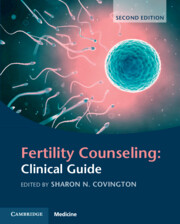Book contents
- Fertility Counseling: Clinical Guide
- Fertility Counseling: Clinical Guide
- Copyright page
- Dedication
- Contents
- Preface
- Contributors
- I Introduction
- II Therapeutic Approaches
- III Third Party Reproduction: Assessment and Preparation
- IV Addressing the Needs of Diverse Populations
- Chapter 15 The Male Experience with Fertility and Counseling
- Chapter 16 Counseling Lesbian, Gay, Bisexual and Queer Fertility Patients
- Chapter 17 Transgender Assisted Reproductive Technology
- Chapter 18 A Racially and Culturally Sensitive Approach to Fertility Counseling
- V Special Topics in Fertility Counseling
- VI Practice Issues
- The International Glossary on Infertility and Fertility Care, 2017
- Index
- References
Chapter 16 - Counseling Lesbian, Gay, Bisexual and Queer Fertility Patients
from IV - Addressing the Needs of Diverse Populations
Published online by Cambridge University Press: 24 November 2022
- Fertility Counseling: Clinical Guide
- Fertility Counseling: Clinical Guide
- Copyright page
- Dedication
- Contents
- Preface
- Contributors
- I Introduction
- II Therapeutic Approaches
- III Third Party Reproduction: Assessment and Preparation
- IV Addressing the Needs of Diverse Populations
- Chapter 15 The Male Experience with Fertility and Counseling
- Chapter 16 Counseling Lesbian, Gay, Bisexual and Queer Fertility Patients
- Chapter 17 Transgender Assisted Reproductive Technology
- Chapter 18 A Racially and Culturally Sensitive Approach to Fertility Counseling
- V Special Topics in Fertility Counseling
- VI Practice Issues
- The International Glossary on Infertility and Fertility Care, 2017
- Index
- References
Summary
Lesbian, gay, bisexual and queer (LGBQ) women and men are increasingly utilizing fertility treatment services to build their families. This chapter provides an overview of topics to consider when providing fertility counseling to this population of prospective parents. It first explores the decisions that same-sex couples need to make with regard to family building and fertility treatment, including various routes to parenthood, whose gametes to use, or who will serve as the carrier. The chapter further explores many of the challenges couples often face during fertility treatment via the sexual minority stress framework. Particular attention is given to issues of homophobic discrimination, heteronormative bias and stigma, as well as to challenges related to social support, costs and legal rights. Finally, this chapter provides guidance to fertility counselors and treatment professionals on steps to take to provide culturally competent care to LGBQ patients and their partners. Such practices are crucial for offering an inclusive treatment environment to support same-sex couples in their family-building efforts.
- Type
- Chapter
- Information
- Fertility Counseling: Clinical Guide , pp. 162 - 171Publisher: Cambridge University PressPrint publication year: 2022

